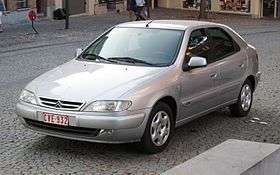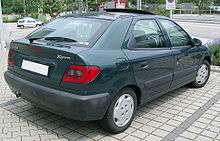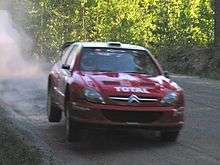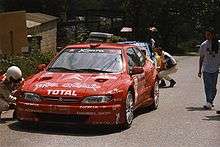Citroën Xsara
| Citroën Xsara | |
|---|---|
 | |
| Overview | |
| Manufacturer | Citroën |
| Production | 1997–2006 |
| Assembly |
France: Rennes (PSA Rennes Plant) Spain: Madrid Villaverde Spain: Vigo (PSA Vigo Plant) Uruguay: Barra de Carrasco (Oferol) China: Wuhan, Hubei Egypt: Cairo (AAV)[1] |
| Body and chassis | |
| Class | Small family car (C) |
| Body style |
5-door hatchback (notchback) 3-door hatchback (notchback) 5-door estate |
| Layout | Front-engine, front-wheel-drive |
| Related |
Citroën ZX Peugeot 306 Citroën Xsara Picasso |
| Dimensions | |
| Wheelbase | 2,540 mm (100.0 in) |
| Length |
5-door: 4,167–4,188 mm (164.1–164.9 in) 3-door: 4,167–4,188 mm (164.1–164.9 in) Estate: 4,350–4,369 mm (171.3–172.0 in) |
| Width | 1,705 mm (67.1 in) |
| Height |
5-door: 1,405 mm (55.3 in) Estate: 1,420 mm (55.9 in) |
| Chronology | |
| Predecessor | Citroën ZX |
| Successor | Citroën C4 |
The Citroën Xsara was a small family car (C-segment in Europe) produced by the French automaker Citroën from 1997 to 2006. The Xsara was a development of the Citroën ZX and Peugeot 306, which shared a platform and running gear.
It came in three and five door hatchback (notchback) and five door estate body styles; the estate was marketed as the Break and the three door as the Coupé. The styling shared cues with the larger Bertone designed Xantia, but was regarded as bland by the motoring press.
The straight four engine range includes 1.4, 1.6, 1.8 and 2.0 litre petrol engines as well as 1.6, 1.9 and 2.0 litre naturally aspirated and turbocharged diesels. In some countries, such as Portugal, the 1.5 litre TUD5 diesel engine was also available.[2] The Xsara was 1998 Semperit Irish Car of the Year in Ireland.
Chassis design

The familiar range of PSA powertrains drove the front wheels of a seemingly conventionally designed chassis. At the front was a standard MacPherson strut layout with anti-roll bar, while the rear used the PSA Peugeot-Citroën fully independent trailing arm/torsion bar set up, which was first introduced on the estate of the Peugeot 305.
However, PSA's chassis engineers employed some unusual features, including passive rear wheel steering, though less than on the ZX, (by means of specially designed compliance bushes in the rear suspension), and inhouse developed and constructed shock absorbers.
At high mileages, this is prone to wear of the axle mounting bushes which is easily fixed. It is also prone to wear in the rear axle trailing arm bearings, which then wear the trailing arm axle tubes, requiring an expensive rebuild or a replacement axle assembly.[3][4][5][6][7]
The diesel and larger capacity petrol engines are canted as far back as possible in the engine bay, in an effort to put as much weight as possible behind the front axle line, also reducing the centre of gravity, while improving weight distribution and minimising understeer.
Overview
Pre-facelift
.jpg)
The original Xsara was launched in September 1997, and was available with different engine choices:
- 1.4L (1361 cc 8 valve SOHC) 55 kW (75 PS; 74 hp) TU3JP 4-cylinder petrol 111 N·m
- 1.6L (1587 cc) 66 kW (90 PS; 89 hp) TU5JP four cylinder petrol 136 N·m
- 1.8L (1761 cc) 66 kW (90 PS; 89 hp) XU7JB four cylinder petrol
- 1.8L (1761 cc) 76 kW (103 PS; 102 hp) XU7JP four cylinder petrol
- 1.8L (1761 cc 16-valve DOHC) 82 kW (110 hp) XU7JP4 four cylinder petrol 155 N·m
- 2.0L (1998 cc) 92 kW (125 PS; 123 hp) XU10J2C four cylinder petrol
- 2.0L (1998 cc 16 valve DOHC) 99 kW (135 PS; 133 hp) XU10J4R four cylinder petrol
- 2.0L (1998 cc 16 valve DOHC) 122 kW (166 PS; 164 hp) XU10J4RS four cylinder petrol (used in Xsara VTS)
- 1.5L (1527 cc) 43 kW (58 PS; 57 hp) TUD5 diesel
- 1.9L (1905 cc) 50 kW (68 PS; 67 hp) XUD9A diesel
- 1.9L (1868 cc) 51 kW (69 PS; 68 hp) DW8 diesel
- 1.9L (1905 cc) 55 kW (75 PS; 74 hp) XUD9B SD diesel
- 1.9L (1905 cc) 66 kW (90 PS; 89 hp) XUD9TE turbodiesel
- 2.0L (1997 cc) 66 kW (90 PS; 89 hp) DW10TD turbodiesel
- 2.0L (1997 cc) 80 kW (109 PS; 107 hp) DW10ATED turbodiesel
Facelift
_%E2%80%93_Heckansicht%2C_17._M%C3%A4rz_2011%2C_W%C3%BClfrath.jpg)
In September 2000, the Xsara was facelifted. The car was now stiffer (safety and handling improved), had a new front design and some interior modifications (i.e.: new steering wheel). The facelift also saw the introduction of multiplex wiring.
However, the wiring used was too thin, resulting in multiple wires breaking with frequent use, especially in the driver's door, thereby rendering the driver's door window, central locking and interior lights unusable. Citroën do not acknowledge this as a problem, and do not issue door wiring harnesses as a spare.
New 1.6i and 2.0i 16 valve engines were being introduced and 1.8L were removed. Now Xsara is offered with following engine choices:
- 1.4L (1361 cc 8 valve SOHC) 55 kW (74 hp) TU3JP four cylinder petrol 121 N·m (catalyst and its position were changed).
- 1.6L (1587 cc 16 valve DOHC) 81 kW (109 hp) TU5JP4 four cylinder petrol (new, replaced 8-valve TU5JP engine)
- 2.0L (1998 cc 16 valve DOHC) 122 kW (164 hp) XU10J4RS four cylinder petrol (used till 2002)
- 2.0L (1998 cc 16 valve DOHC) 101 kW (135 hp) EW10J4 four cylinder petrol (new, replaced XU10 engine)
- 1.4L (1398 cc) HDI 50 KW 68 PS DW4TD 01. 2004–31 December 2004
- 1.5L (1527 cc) 43 kW (58 PS; 57 hp) TUD5 diesel
- 1.9L (1868 cc) 51 kW (69 PS; 68 hp) DW8 diesel (used till 2002)
- 1.9L (1868 cc) 53 kW (72 PS; 71 hp) DW8B diesel (new)
- 2.0L (1997 cc) 66 kW (90 PS; 89 hp) DW10TD turbodiesel (catalyst was changed, later central silencer was removed)
- 2.0L (1997 cc) 79 kW (107 PS; 106 hp) DW10ATED turbodiesel (new)
The model of 2002 had slight interior modifications (e.g. a different way of controlling the sound system from the steering wheel). In February 2003, there were also some exterior modifications (e.g. new front bumper).
The Xsara hatchback was discontinued, and replaced by the C4 in November 2004. The Xsara continues to be produced for the Chinese market by Dongfeng Peugeot-Citroën Automobile, a joint venture with the PSA Group. The Xsara Picasso small MPV was continued, concurrently with its successor that was based on the C4. 'Picasso' becoming the name for MPV derivatives of any Citroën model.
Xsara WRC


The Xsara World Rally Car, based on the road going Xsara hatchback but ultimately having very little resemblance to it under the skin, was one of the most successful cars ever to compete in the World Rally Championship. In 1999, the WRCs predecessor, the two wheel drive naturally aspirated Xsara Kit Car, won overall in Rallye Catalunya and Tour de Corse. This car was considered the best car in the class. The late Philippe Bugalski placed seventh overall and won the Kit Car F2 class.
In 2001, Kit Cars category disappeared and was replaced by Super 1600 and Super 2000. Citroën Xsara competed in the category of World Rally Car. In 2002, French driver Sébastien Loeb was supposed to win the Monte Carlo Rally but he was penalized for an illegal tyre change, but he later won the Deutschland Rally.
In 2003, the Citroën Xsara was more competitive. In Wales GB, the leader Richard Burns suffered a blackout and withdrew from the rally. Sébastien Loeb made some mistakes on the last round and he lost the championship by just one point.
However, the Citroën won the manufacturers' title and in 2004 Sébastien loeb won the championship. The car took Sébastien Loeb to 28 rally wins, three consecutive Driver's Championship titles from 2004 to 2006, and Citroën to three consecutive Manufacturer's Championship titles in 2003, 2004, and 2005.
Although it is the Frenchman who has proved the archetype Xsara WRC pilot virtually since its 2001 conception, Jesús Puras, Carlos Sainz and François Duval are the other drivers who have won. The car was replaced in 2007 by the Citroën C4 WRC, however the Xsara was still used by privateers and others. 2003 world champion Petter Solberg drove a 2006 spec Xsara for the majority of the season of 2009, which was entered by his own Petter Solberg World Rally Team.[8]
Rallycross
Kenneth Hansen won the FIA European Rallycross Championship every year from 2000 to 2005.
In September 2014, French based Lebanese businessman Nabil Karam entered the 2014 World RX of France with an Xsara, finishing 34th out of 37 entrants after the qualifying heats, and failing to qualify for the semi finals. Having upgraded to a DS3 for the 2015 edition, this is the only time an Xsara has been used in a World Championship rallycross event.
WRC victories
| # | Event | Season | Driver | Co-driver |
|---|---|---|---|---|
| 1 | 2001 | |||
| 2 | 2002 | |||
| 3 | 2003 | |||
| 4 | 2003 | |||
| 5 | 2003 | |||
| 6 | 2003 | |||
| 7 | 2004 | |||
| 8 | 2004 | |||
| 9 | 2004 | |||
| 10 | 2004 | |||
| 11 | 2004 | |||
| 12 | 2004 | |||
| 13 | 2004 | |||
| 14 | 2005 | |||
| 15 | 2005 | |||
| 16 | 2005 | |||
| 17 | 2005 | |||
| 18 | 2005 | |||
| 19 | 2005 | |||
| 20 | 2005 | |||
| 21 | 2005 | |||
| 22 | 2005 | |||
| 23 | 2005 | |||
| 24 | 2005 | |||
| 25 | 2006 | |||
| 26 | 2006 | |||
| 27 | 2006 | |||
| 28 | 2006 | |||
| 29 | 2006 | |||
| 30 | 2006 | |||
| 31 | 2006 | |||
| 32 | 2006 |
| Awards | ||
|---|---|---|
| Preceded by Peugeot 206 WRC |
Autosport Rally Car of the Year 2003, 2004, 2005 |
Succeeded by Ford Focus RS WRC |
Sales and production
| Year | Worldwide production | Worldwide sales | Notes |
|---|---|---|---|
| 2012 | 1,800[9] | TBA | Total production reaches 3,364,000 units.[9] |
See also
References
- ↑ "Arab American Vehicles Co". Aav.com.eg. Archived from the original on 9 February 2010. Retrieved 25 March 2010.
- ↑ "Lot 143: Xsara Break 1.5 D Phase I", Vente des réserves de l'Aventure Peugeot Citroën DS (Auction Catalogue) (in French), Leclere Maison des Ventes, 10 December 2017, p. 154, archived from the original on 26 November 2017
- ↑ "Zx Volcane Rear Suspension". Citroen Owners Club. The citroen cars forums.
- ↑ "ZX rear swing arm bearings - Technical matters - Back Room Forum - Honest John". honestjohn.co.uk.
- ↑ "Citroen ZX Suspension and steering". Docstoc.com.
- ↑ "ZX Radius arm bearings - French Car Forum". frenchcarforum.co.uk.
- ↑ "A B Axles - Reconditioned and Refurbished Peugeot & Citroen Rear Axles". sspengineering.co.uk.
- ↑ "World Rally Championship – Rallies". Wrc.com. Archived from the original on 8 July 2009. Retrieved 6 October 2009.
- 1 2 "Memento Mars 2013" (in French). PSA Peugeot Citroën. 21 February 2013: 50. Retrieved 31 July 2013.
External links
| Wikimedia Commons has media related to Citroën Xsara. |
- Xsara Picasso Official UK site
- Xsara model information
- Citroën Crash Test Xsara
- Meaning of word "Xsara"
« previous — Citroën car timeline, 1980s–present | ||||||||||||||||||||||||||||||||||||||
|---|---|---|---|---|---|---|---|---|---|---|---|---|---|---|---|---|---|---|---|---|---|---|---|---|---|---|---|---|---|---|---|---|---|---|---|---|---|---|
| Type | 1980s | 1990s | 2000s | 2010s | ||||||||||||||||||||||||||||||||||
| 0 | 1 | 2 | 3 | 4 | 5 | 6 | 7 | 8 | 9 | 0 | 1 | 2 | 3 | 4 | 5 | 6 | 7 | 8 | 9 | 0 | 1 | 2 | 3 | 4 | 5 | 6 | 7 | 8 | 9 | 0 | 1 | 2 | 3 | 4 | 5 | 6 | 7 | |
| Economy car | 2CV | |||||||||||||||||||||||||||||||||||||
| Off-roader | Méhari | |||||||||||||||||||||||||||||||||||||
| Supermini | LN / LNA | AX | C1 I | C1 II | ||||||||||||||||||||||||||||||||||
| Dyane | Axel | Saxo | C2 | DS3 | ||||||||||||||||||||||||||||||||||
| Visa | C3 I | C3 II | C3 III | |||||||||||||||||||||||||||||||||||
| Small family car | C-Elysée | |||||||||||||||||||||||||||||||||||||
| C4 Cactus | ||||||||||||||||||||||||||||||||||||||
| GSA | ZX | Xsara | C4 I | C4 II | ||||||||||||||||||||||||||||||||||
| DS4 | ||||||||||||||||||||||||||||||||||||||
| Large family car | BX | Xantia | C5 I | C5 II | ||||||||||||||||||||||||||||||||||
| DS5 | ||||||||||||||||||||||||||||||||||||||
| Executive car | CX | XM | C6 | |||||||||||||||||||||||||||||||||||
| Convertible | Visa cabriolet | C3 Pluriel | E-Méhari | |||||||||||||||||||||||||||||||||||
| Mini MPV | Nemo Multispace | |||||||||||||||||||||||||||||||||||||
| Compact MPV | Xsara Picasso | C3 Picasso | ||||||||||||||||||||||||||||||||||||
| C4 Picasso I | C4 Picasso II | |||||||||||||||||||||||||||||||||||||
| Large MPV | Evasion | C8 | ||||||||||||||||||||||||||||||||||||
| Mini crossover | C3 Aircross | |||||||||||||||||||||||||||||||||||||
| C3-XR | ||||||||||||||||||||||||||||||||||||||
| Crossover SUV | C4 Aircross | |||||||||||||||||||||||||||||||||||||
| C-Crosser | C5 Aircross | |||||||||||||||||||||||||||||||||||||
| LAV | Acadiane | C15 | Nemo | |||||||||||||||||||||||||||||||||||
| Berlingo | Berlingo II | |||||||||||||||||||||||||||||||||||||
| Van | H Van | C25 | Jumpy I | Jumpy II | Space Tourer | |||||||||||||||||||||||||||||||||
| C35 | Jumper I | Jumper II | ||||||||||||||||||||||||||||||||||||
| Note | DS Automobiles | |||||||||||||||||||||||||||||||||||||